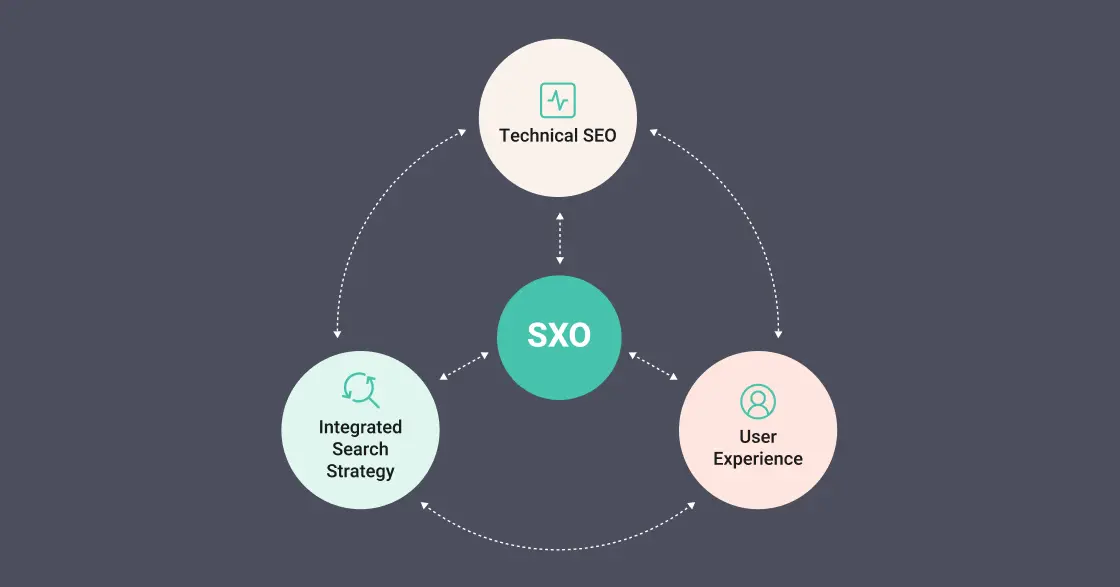From SEO & SEM to Search Experience Optimisation (SXO)

A new paradigm in search marketing
Traditionally, Search Engine Optimisation (SEO) and Search Engine Marketing (SEM) were digital marketing strategies aimed at assisting users in discovering and directing them to websites and apps. The traffic generated through these channels had a significant impact on commercial performance. A strong SEO strategy, a well-executed SEM campaign, and an optimisation strategy for landing pages were sufficient to enhance visibility, traffic, and conversion rates.
Search engines have evolved considerably as user needs have evolved, resulting in rapid evolution in search engine strategy, with the most significant being Search Experience Optimization (SXO).
Optimising the multi-channel digital experience requires a new approach to core digital marketing functions like SEO, SEM, and performance marketing, working collaboratively with other disciplines.
Key Takeaways.
- 93% of web experiences begin on search engines
- Focus on understanding your users search intent and optimising the entire customer journey
- SXO optimisation looks at all customer journey touchpoints: voice search, search pages, rich snippets, map listings, websites, apps, and social media profiles
- SXO integrates SEO, SEM, UX, UI, and technical optimisations to enhance multimedia user experiences
- It's essential to create high-quality, relevant content and optimise technical aspects for user satisfaction and search engine rankings
- SXO is an ongoing, iterative process that evolves based on user feedback and changing business needs
- The ultimate goal is to improve online presence, drive more traffic, and boost conversions, revenue, and customer retention
- equ has cross-functional agile teams ready to assist organisations aiming to transition towards an SXO approach
Why Is UX an important element of SEO?
Google and other search engines have consistently considered the user experience element of websites when ranking them in search results. Over the years, Google has introduced various algorithm updates, including Panda in 2011, Penguin in 2012, Hummingbird in 2013, and RankBrain in 2015, all of which were aimed at improving the assessment of a webpage's quality and user-friendliness.
Then, in May 2020, Google launched Core Web Vitals, which made real-world user experience factors such as loading performance, interactivity, and visual stability of the page significant ranking factors. As search engines evolve into AI-driven multimedia hubs enriched with content from numerous digital platforms, a new model of SEO and SEM is emerging that incorporates UX.
The SXO approach
The SXO approach seamlessly integrates traditional performance marketing tactics with UI (User Interface) design, UX (User Experience) design, and technical optimisations of digital platforms to deliver the best possible user experience, boost traffic, and enhance digital performance, ultimately fostering growth, conversions, engagement, or revenue.
This new UX-driven approach focuses on optimising the user's complete experience, encompassing voice search results, paid search features, organic search results, the website or app experience, and how users are retargeted across the digital ecosystem, ranging from remarketing lists for search ads (RLSA) campaigns to programmatic BVOD retargeting on their IP-connected TV.
UX-driven Search Optimisation
Both UI (User Interface) and UX (User Experience) design play significant roles in SXO, contributing to the overall user experience across digital interfaces, apps, and websites. They are responsible for visual and information architecture, simplicity, usability, user-centricity, typography, accessibility, consistency, context, and user control within these experiences.
The primary goal of SXO is to first understand users' search intent and their customer journey, then provide high-quality, relevant content that is easy to consume and navigate, ultimately delivering the information the user is seeking.
SXO and the Customer Journey
SXO acknowledges that the customer journey may commence beyond the confines of traditional search channels, including voice search. In cases where the search intent is for straightforward information such as obtaining a phone number, address, or a quick answer, it can conclude without even visiting a website (also known as zero-click search).
SXO encompasses the optimisation of all components within the customer journey, ranging from voice search results, search result pages, rich snippets, map listings, websites, apps, social media profiles, and other digital platforms. This optimisation extends to both content and technical aspects.
By delivering the best possible user experience across all of the organisation's customer touchpoints, SXO has the potential to enhance your online presence, generate increased traffic, satisfy user needs, and ultimately boost conversions, revenue, and customer retention.
Key Elements of an SXO Strategy
SXO Strategy is a multidisciplinary practice because it involves a variety of disciplines working together to create a positive user experience that meets the user's search intent and informational requirements while providing a satisfying experience. At equ the key elements of Search Experience Optimisation (SXO) include:
Understanding user intent: The first step in SXO is to understand the user's intent behind their search query. This involves researching the most common search queries related to your organisation and understanding what the user is looking for when they perform those searches.
Customer journey mapping: A customer journey map is a storyline of every engagement a customer has with a service, brand, or product. The creation of a journey map puts the organisation directly in the mind of the consumer, so they can see and understand their customer's processes, needs, and perceptions.
UX design: The process of designing digital or physical products and services with the user's needs and preferences in mind involves user research, developing an Information Architecture (IA), prototyping, visual design, and user testing.
UI design: UI is likely the first thing you encounter when you use an app, visit a website or engage in a digital experience. User interface design works through wireframing, visual design, and prototyping of interactive elements like buttons, menus, icons, and screens that drive the product or service's appearance, interactivity, usability, behaviour, and overall feel.
Content optimisation: Once we understand the user's intent and journey, we can optimise your search result, website, app, or digital experiences with UX copywriting to meet their needs. This includes creating high-quality, relevant content that is easy to consume or read and that provides the information the user is looking for.
Technical optimisation: Technical optimisation involves optimising your website, app, or platform’s technical aspects to ensure that it loads quickly, is mobile-friendly, and has a clear structure. This makes it easier for both users and search engines to navigate your digital experience.
UX optimisation: In SXO, it's not enough to simply deliver a good design, content, and technical optimisation. The user experience in the real world must also be taken into account and optimised over time. We observe, measure and A/B test the digital experience through an iterative process that ensures it is easy to navigate, has clear calls to action and is designed with the user in mind.
Local optimisation: For organisations that rely on local customers, local optimisation is essential. This involves optimising your website for local search queries, such as "best degustation menu in Perth," and ensuring that your business information is consistent across all directories, review sites, and other digital platforms that form part of a local customer journey.
Social media optimisation: Social media plays a significant role in SXO, as it can drive traffic to your website or app and increase your online presence. Optimising your social media profiles and ensuring that your content is shareable can help to increase your visibility and drive more traffic to your website.
These key steps are often part of an iterative process that involves ongoing refinement and improvement based on user feedback and changing business needs.
equ’s cross-funtional SXO Team
equ has cross-functional agile teams ready to assist organisations aiming to transition towards an SXO approach. Our UX specialists collaborate closely with our Performance Marketing team, including SEO and Paid Search specialists, to blend data, user research, prototyping, and user testing. This collaboration enables our developers to craft exceptional, user-centric digital experiences that resonate with users and align with search engine algorithms.
In summary, the essence of SXO lies in prioritising the delivery of the best possible user experience while also optimising digital experiences for search engines. Embracing a holistic and iterative approach to optimisation will enhance your online presence, increase website traffic, and ultimately elevate conversions, revenue, and customer retention.
If you would like to learn more about SXO, feel free to contact us today.






